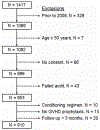Effect of donor type and conditioning regimen intensity on allogeneic transplantation outcomes in patients with sickle cell disease: a retrospective multicentre, cohort study
- PMID: 31495699
- PMCID: PMC6813907
- DOI: 10.1016/S2352-3026(19)30154-1
Effect of donor type and conditioning regimen intensity on allogeneic transplantation outcomes in patients with sickle cell disease: a retrospective multicentre, cohort study
Abstract
Background: Donors other than matched siblings and low-intensity conditioning regimens are increasingly used in haematopoietic stem cell transplantation. We aimed to compare the relative risk of donor type and conditioning regimen intensity on the transplantation outcomes of in patients with sickle cell disease.
Methods: For this retrospective cohort study, we collected data from 90 US centres reported to the Center for International Blood and Marrow Transplant Research. Eligible patients were younger than 50 years, had genetically confirmed sickle cell disease (Hb SS) or sickle beta thalassemia (Hb Sβ), and underwent allogeneic haematopoietic cell transplantation between Jan 15, 2008, and Dec 28, 2017. We considered transplants from donor-recipient pairs matched at the allele-level (HLA-A, HLA-B, HLA-C, and HLA-DRB1), including HLA-matched sibling donors, haploidentical related donors, matched unrelated donors, or mismatched unrelated donors. The main outcome was event-free survival. The effect of donor type, conditioning regimen intensity (myeloablative, non-myeloablative, and reduced-intensity regimens), age (≤12 or 13-49 years), sex, performance score, comorbidity index, recipient cytomegalovirus serostatus, graft type (bone marrow, peripheral blood, or umbilical cord blood), and transplantation period (2008-12 and 2013-17) on outcomes was studied using Cox regression models.
Findings: Of 996 patients with sickle cell disease and who underwent transplantation in 2008-17, 910 (91%) were included (558 [61%] patients had HLA-matched sibling donors, 137 [15%] haploidentical related donors, 111 [12%] matched unrelated donors, and 104 [11%] mismatched unrelated donors). The median follow-up was 36 months (IQR 18-60) after transplantation from HLA-matched siblings, 25 months (12-48) after transplantation from haploidentical related donors, 37 months (23-60) after transplantation from HLA-matched unrelated donors, and 47 months (24-72) after transplantation from mismatched unrelated donors. Event-free survival was worse in recipients aged 13 years or older than in those younger than 13 years (hazard ratio 1·74, 95% CI 1·24-2·45; p=0·0014) and in those who received a transplant from haploidentical related donors (5·30, 3·17-8·86; p<0·0001), matched unrelated donors (3·71, 2·39-5·75; p<0·0001), and mismatched unrelated donors (4·34, 2·58-7·32; p<0·0001) than in patients who received a transplant from matched siblings. There was no significant difference in event-free survival between recipients of transplants from non-sibling donors: haploidentical related donors (1·43, 0·81-2·50; p=0·21) or mismatched unrelated donors (1·17, 0·67-2·05; p=0·58) versus HLA-matched unrelated donors, or mismatched unrelated donors versus haploidentical related donors (1·22, 0·65-2·27; p=0·98). Event-free survival was also worse in patients conditioned with reduced-intensity regimens (1·97, 1·15-3·36; p=0·013) than in those conditioned with non-myeloablative regimens, but did not differ between those who received myeloablative compared with non-myeloablative regimens (1·57, 0·95-2·61; p=0·079). Interpretation Our data suggest that event-free survival is improved in patients with sickle cell disease who receive an allogenic transplantation at age 12 years or younger and those with an HLA-matched sibling donor. For patients without a matched sibling available for transplantation, our data do not favour one alternative donor type over another in this setting.
Funding: National Institutes of Health and US Health Services Research Administration, Department of Health and Human Services.
Copyright © 2019 Elsevier Ltd. All rights reserved.
Conflict of interest statement
Conflict of Interest: Authors declare none
Figures


Comment in
-
Stem cell transplantation in sickle-cell disease.Lancet Haematol. 2019 Nov;6(11):e547-e548. doi: 10.1016/S2352-3026(19)30150-4. Epub 2019 Sep 5. Lancet Haematol. 2019. PMID: 31495698 No abstract available.
References
-
- Walters MC, Patience M, Leisering M, et al. Bone marrow transplantation for sickle cell disease. N Engl J Med 1996; 335: 369–76 - PubMed
MeSH terms
Grants and funding
LinkOut - more resources
Full Text Sources
Medical
Molecular Biology Databases
Research Materials

